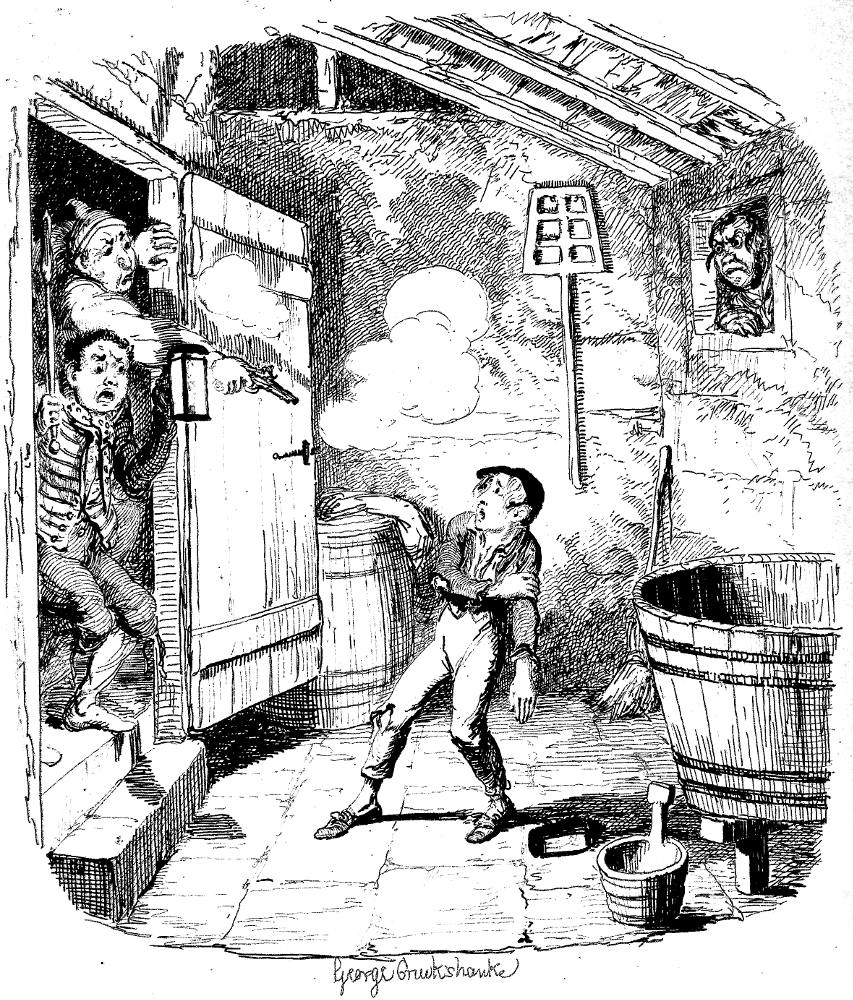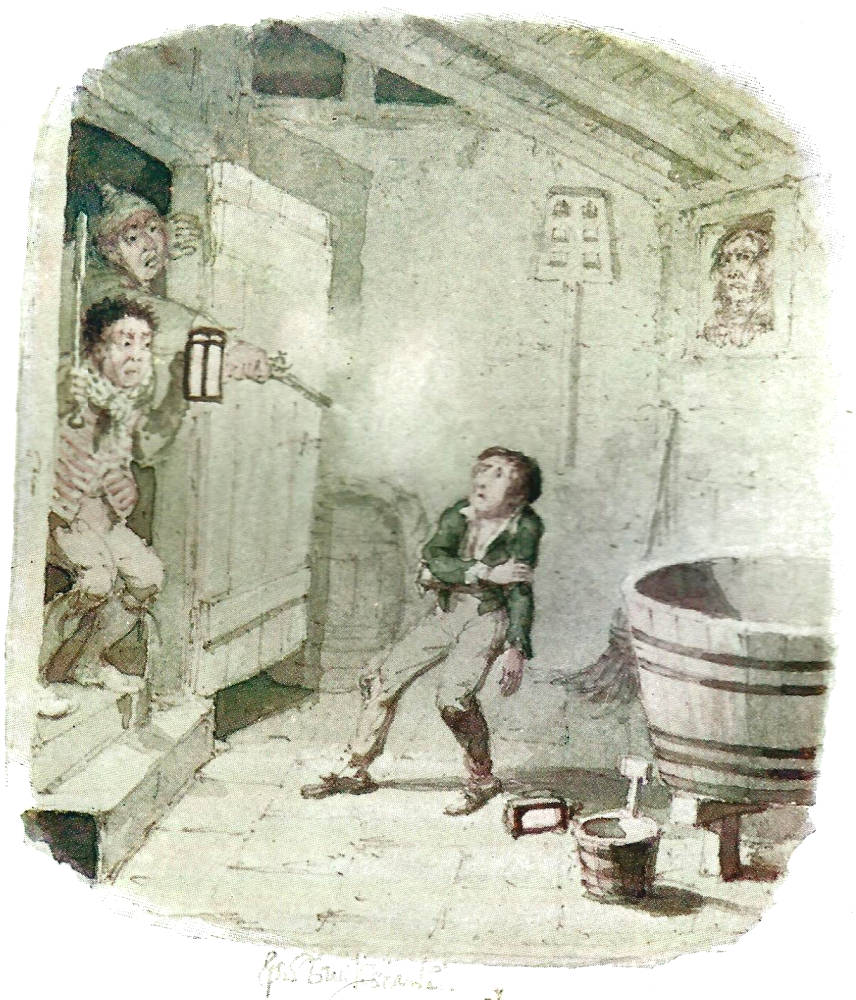

The Burglary — the tenth steel engraving and later a watercolour for Charles Dickens's The Adventures of Oliver Twist; or, The Parish Boy's Progress, first published in volume by Richard Bentley after its January 1838 appearance in Bentley's Miscellany, Chapter XXII (tenth instalment). 4 ¼ by 3 ¾ inches (10.8 cm by 9.6 cm), vignetted, facing page 123 in the 1846 edition (originally leading off the monthly number). Cruikshank's own 1866 watercolour, commissioned by book-collector F. W. Cosens, is the basis for the 1911 chromolithograph. [Click on the images to enlarge them.]
Passage Illustrated: The Robbery Interrupted
They listened intently.
"Nothing," said Sikes, releasing his hold of Oliver. "Now!"
In the short time he had had to collect his senses, the boy had firmly resolved that, whether he died in the attempt or not, he would make one effort to dart upstairs from the hall, and alarm the family. Filled with this idea, he advanced at once, but stealthily.
"Come back!" suddenly cried Sikes aloud. "Back! back!"
Scared by the sudden breaking of the dead stillness of the place, and by a loud cry which followed it, Oliver let his lantern fall, and knew not whether to advance or fly.
The cry was repeated — a light appeared — a vision of two terrified half-dressed men at the top of the stairs swam before his eyes — a flash — a loud noise — a smoke — a crash somewhere, but where he knew not, — and he staggered back.
Sikes had disappeared for an instant; but he was up again, and had him by the collar before the smoke had cleared away. He fired his own pistol after the men, who were already retreating; and dragged the boy up.
"Clasp your arm tighter," said Sikes, as he drew him through the window. "Give me a shawl here. They've hit him. Quick! How the boy bleeds!"
Then came the loud ringing of a bell, mingled with the noise of fire-arms, and the shouts of men, and the sensation of being carried over uneven ground at a rapid pace. And then, the noises grew confused in the distance; and a cold deadly feeling crept over the boy's heart; and he saw or heard no more. [Chapter XXII, "The Burglary," p. 123 in the 1846 edition]

Above: the window of Pyrcroft House, Chertsey, which is thought to have been the model for the window featured in the burglary episode (photograph taken of the window in situ in August 2005 by Jackie Banerjee). The original of the home in Surrey, Lynch speculates, is either a building in Gogmore Lane or, as tradition has it, Pycroft House, in Pycroft Street, now a school. The window, known as "Oliver's Window," has been relocated to the Morning Room of the Charles Dickens Museum at 48 Doughty Street, Holborn, London.
Commentary: Oliver the Victim Once Again
The passage illustrated constitutes a "curtain" at the close of a serial instalment, in this case of chapters twenty through twenty-two, so that Dickens keeps readers in suspense for a month, waiting to see whether Oliver will recover or expire from his wounds as he lies in a ditch, and whether he will face incarceration or return to the thieves' den as a veteran housebreaker.
By sheer coincidence or through the machinations of Providence, the house in Chertsey that Sikes has selected as his target belongs to the Maylies, the family who adopted Rose, the sister of Agnes, Oliver's mother. Although Dickens's official illustrator for Oliver Twist, George Cruikshank depicts the heavy-faced housebreaker Bill Sikes as the sordid, lower-class villain out of contemporary melodrama, the figure whom Felix Octavius Carr Darley in his 1888 series of Character Sketches from Dickens describes is much more of an individual (despite his characteristic long face and white top hat derived directly from Cruikshank) than a type.
In the chapter 22 illustration which depicts Oliver's being surprised and shot at as soon as he has entered the Chertsey house that Sikes and Crackit have intended to rob, Cruikshank minimizes the previously intimidating bulk of the notorious housebreaker by confining him to a mere facial likeness in the frame window five-and-a-half feet off the ground outside — in a framed portrait, so to speak — as Sikes watches the unfolding scene with intense interest but relative impotence. For all his physical force, Sikes here is powerless to intervene to save Oliver or assault the servants who are discharging firearms. Effectively rendered, Cruikshank's ruffian is unshaven, unkempt, and full-faced — but the small window through which he peers would prevent him from firing his own weapon on the two servants, let alone haul Oliver out if harm's way by the collar in the text on the page facing the steel-engraving, which intensifies the suspense at the end of the monthly part, as the author reports the protagonist's sensations of being hoisted up through the tiny window, dragged across the ground, and left to die in a ditch. The same improbability associated with the window is apparent in Harry Furniss's rendition of the same dramatic moment.
In the monthly wrapper containing eleven scenes from the novel for the 1846 "re-serialization," Cruikshank (rather than Dickens's usual illustrator of the 1840s, Hablot Knight Browne) includes in the design's upper left-hand corner Sikes at the window on the outside of the house, gesticulating as if telling Oliver how to open the door for Sikes himself, Nancy, and Toby Crackit once Oliver has descended to the floor; by its prominence in the wrapper, Cruikshank is implying that the incident is significant in Oliver's moral "progress." In the Household Edition, however, Mahoney focuses on two scenes immediately preceding the botched robbery, perhaps aware that his readers would inevitably compare his treatment of The Burglary to Cruikshank's. Such a consideration, however, did not prevent Harry Furniss from attempting a much more dynamic composition in which the focus is the four servants who burst into the storeroom as Oliver is about to pass out. Seeing the picture before reading the accompanying text, one might expect the worst, but by the end of the closing curtain Sikes has at least abstracted Oliver from the immediate danger posed by the armed servants — who become four in number in the Furniss illustration.
Relevant Illustrations from the serial and later editions (1837-1910)



Left: Sol Eytinge, Junior's Bill Sikes and Nancy (1867). Centre: F. O. C. Darley's Bill Sikes, Nancy, and Oliver (1888). Right: Mahoney's Household Edition illustration Sikes, with Oliver's hand still in his, softly approached the low porch (1871). [Click on the various images to enlarge them.]



Left: James Mahoney's "Directly I leave go of you, do your work. Hark!" (1871). Centre: Harry Furniss's Oliver in the Grip of Sikes (1910). Right: Harry Furniss's "The Burglary" (1910). [Click on images to enlarge them.]
Scanned images and text by Philip V. Allingham. [You may use these images without prior permission for any scholarly or educational purpose as long as you (1) credit the photographer and (2) link your document to this URL in a web document or cite the Victorian Web in a print one.]
Bibliography
Bentley, Nicolas, Michael Slater, and Nina Burgis. The Dickens Index. New York and Oxford: Oxford U. P., 1990.
Cohen, Jane Rabb. "George Cruikshank." Charles Dickens and His Original Illustrators. Columbus: Ohio State U. P., 1980. Pp. 15-38.
Darley, Felix Octavius Carr. Character Sketches from Dickens. Philadelphia: Porter and Coates, 1888.
Davis, Paul. Charles Dickens A to Z: The Essential Reference to His Life and Work. New York: Facts On File, 1998.
Dickens, Charles. The Adventures of Oliver Twist; or, The Parish Boy's Progress. Illustrated by George Cruikshank. London: Bradbury and Evans; Chapman and Hall, 1846.
_______. Oliver Twist. Works of Charles Dickens. Household Edition. 55 vols. Illustrated by F. O. C. Darley and John Gilbert. New York: Sheldon and Co., 1865.
_______. Oliver Twist. Works of Charles Dickens. Diamond Edition. 14 vols. Illustrated by Sol Eytinge, Jr. Boston: Ticknor and Fields, 1867.
_______. Oliver Twist. Works of Charles Dickens. Household Edition. 22 vols. Illustrated by James Mahoney. London: Chapman and Hall, 1871. Vol. I.
_______. The Adventures of Oliver Twist. Works of Charles Dickens. Charles Dickens Library Edition. 18 vols. Illustrated by Harry Furniss. London: Educational Book Company, 1910. Vol. 3.
Forster, John. "Oliver Twist 1838." The Life of Charles Dickens. Ed. B. W. Matz. The Memorial Edition. 2 vols. Philadelphia: J. B. Lippincott, 1911. Vol. 1, book 2, chapter 3. Pp. 91-99.
Grego, Joseph (intro). Cruikshank's Water Colours. [27 Oliver Twist illustrations, including the wrapper and the 13-vignette title-page produced for F. W. Cosens; 20 plates for William Harrison Ainsworth's The Miser's Daughter: A Tale of the Year 1774; 20 plates plus the proofcover the work for W. H. Maxwell's History of the Irish Rebellion in 1798 and Emmetts Insurrection in 1803]. London: A & C Black, 1903. OT = pp. 1-106]. Book in the Rare Book Collection of the University of Toronto.
Kitton, Frederic G. "George Cruikshank." Dickens and His Illustrators: Cruikshank, Seymour, Buss, "Phiz," Cattermole, Leech, Doyle, Stanfield, Maclise, Tenniel, Frank Stone, Topham, Marcus Stone, and Luke Fildes. 1899. Rpt. Honolulu: U. Press of the Pacific, 2004. Pp. 1-28.
Pailthorpe, Frederic W. (Illustrator). Charles Dickens's Oliver Twist. London: Robson & Kerslake, 1886. Set No. 118 (coloured) of 200 sets of proof impressions.
Patten, Robert L. George Cruikshank's Life, Times, and Art, Volume Two: 1836-1878. New Brunswick, New Jersey: Rutgers University Press, 1996.
Patten, Robert L. George Cruikshank: A Revaluation. Princeton: Princeton U. P., 1992.
Created 31 August 2014 Last modified 23 December 2021